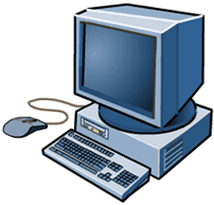
Basic Introduction to Computers

Its almost impossible to cover on a single page all the subject areas to introduce beginners to computers, but here's an attemp.
First, let me get on to some technical terms that are used quite often....
Application software & Operating System software:Operating System software is the environment in which you run all the programs. To put it plain and simple, its what appears when you start your computer(Windows, Linux, Unix, DOS, OS2, MacOS etc). It performs the management of all the resources on your system and often provides network support(in the case of Windows and most versions of Linux).
Application software, on the other hand are programs developed to run on an operating system, such as Microsoft Word, Excel, Lotus 1-2-3, Windows Media Player, Internet Explorer, Microsoft Outlook etc. It runs within your operating system and works within the restrictions imposed by it.
RAM(Random Access Memory): The actual physical memory that your system contains. In most cases, you can add a memory module to get more memory.Why should you be concerned about the RAM? Because some operating systems and application software have a minimum limit with which they can run. Take the following examples:
Operating System Min. Req. Windows 95 8MB Windows 98 16MB Windows ME 32MB Windows NT4 16MB Windows 2000 Professional 64MB Windows 2000 Server 128MB Red Hat Linux 7.2 48MB
Some special applications may take up more memory, such as running a terminal server, Virtual Machine, gaming, graphic applications etc.
Virtual memory: Even if you run your operating system with the minimum amount of memory, some operating systems can use a part of the hard disk as an extension of the memory so it can move the data, which is not frequently used in the memory, to a location on the hard disk called the swap file or swap partition(Swap file/Swap partition = contents of virtual memory). As you can imagine, this reduces the speed of accessing or storing data into the memory because data has to be moved to the slower hard disk(writing to the hard disk is a mechanical process more than an electronic process). This problem however, is being improved with faster hard disks and may be eliminated with the introduction of solid state hard disks (these work electronically rather than mechanically, though they can be very expensive).
Browser: This is an application software that you use to access HTML pages via a protocol called HTTP, on the internet, such as Netscape Navigator, Internet Explorer, Opera, Lynx, Mozilla, NeoPlanet etc.
Driver: Driver? Driver! Go get my car! No, I don't mean the driver who drives a car everyday. I mean a driver, which isn't a golf club either.....
A driver is a piece of software that plugs into the operating system to allow it to work certain devices. This is required because due to the large variety of software available, it is not possible to get everything into the operating system. Also, this allows future expansion of the capabilities of the operating system. For example, my Epson Stylus Color 680 printer doesnt work with the driver of my old HP Deskjet 640C because the instructions accepted by the Epson printer are different from that of the HP. Also, my Epson printer gives me an indication of how much ink is left in the catridge whereas my HP printer does not. When I installed Red Hat Linux 7.2, it wouldn't detect my Lucent Winmodem till I added the drivers that someone made up for it.